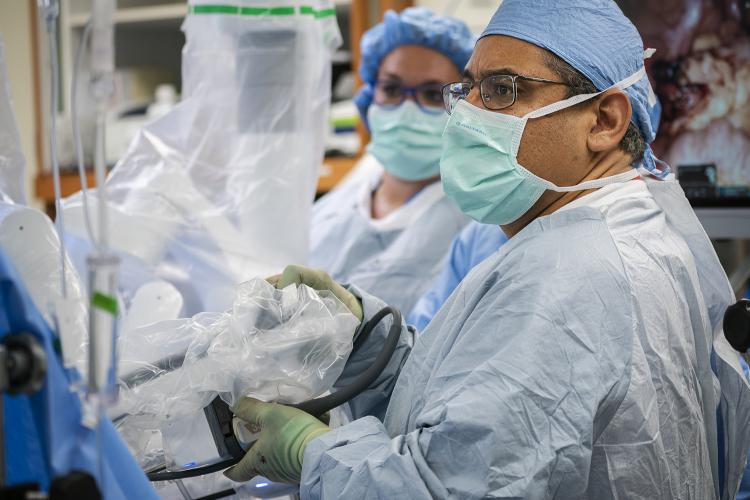
Surgeon Dr. Fernando Garcia is performing state-of-the-art hernia surgeries at JPS.
A robot-assisted hernia operation he completed in May is believed to be the first of its kind performed in Fort Worth. Garcia said it will allow a woman who was left unable to work or perform many routine daily activities to reclaim her life. Incredibly, it only required her to spend two days in the hospital.
“It’s called a transversus robotic abdominal release,” Garcia said of the operation. “It works amazingly well for patients who, because of sickness, accident or a previous hernia repair that went bad, have an abdominal catastrophe.”
Garcia said the woman he operated on had a previous hernia operation after issues developed following a caesarian section birth. The hernia mesh used to make the first surgical repair ultimately failed, leaving the woman with nothing but skin protecting her intestines that spilled outside of her abdominal cavity.
In the past, to repair such a large problem would require an incision from the patient’s breast bone to her public bone and a 30 cm by 28 cm piece of surgical mesh to act as an abdominal wall patch, Garcia said. The wound would take a long time to heal after the operation, according to the surgeon, and the repair was, unfortunately, likely to fail sooner or later. The new operation, which is performed with the help of a da Vinci surgical robot, requires only six very small incisions – three on each side of the abdomen. The revolutionary part of the procedure is that the abdominal wall is rebuilt by relocating other muscles to provide the structure. Those muscles will be reinforced with mesh as opposed to the mesh being counted on to provide the primary strength for the repair.
Garcia said, prior to the operation the patient receives botox injections in the muscles on the side of the abdomen to temporarily paralyze and relax them so they can be stretched around to the front of the body. He compared the procedure to making a wooden frame to allow wet concrete to be shaped. By the time the botox wears off in six months, the muscles will have healed and conformed to their new shape like the concrete does after it has dried. Because the layers of muscle are three layers thick on each side of the abdomen, one of the layers can be spared. So, the internal oblique is cut free and pulled toward the area where the “six-pack” muscles are typically located in the belly. There, the tendons are sewn together to create a lasting, durable hernia repair that’s also much less invasive for patients to endure.
The robot-assisted operation has a six-week recovery period, according to Garcia, which is much shorter than it would take for an open operation that required cuts through layers of muscle to heal. Eliminating the large incision also greatly decreases the opportunity for surgical site infections to develop, reducing the potential for serious complications.
“I’ve seen the patient two times for follow ups since the surgery and she’s doing great,” Garcia said. “I’m very encouraged by the results.”
Use of the da Vinci surgical robot is becoming increasingly commonplace, according to Garcia. It’s precision and
Using a 3D vision system and with stability and articulation capabilities beyond those of human hands, the da Vinci is causing the capabilities of surgeons to grow in ways not thought possible even a few years ago, according to Garcia. He said he uses the Da Vinci on 70-80 percent of operations he performs these days.
“It allows us to extend what we can do,” Garcia said. “It’s really wonderful that we are able to help people in ways we couldn’t have done before.
